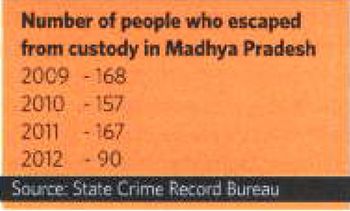A jailbreak by seven inmates of the Tantya Bhil District Jail in Khandwa on the night of September 30 has put the focus on the abysmal conditions in the correctional facilities in Madhya Pradesh. When it comes to guarding jails, the state has had a poor record. From 2009 to 2012, as many as 582 prisoners escaped from custody, according to the State Crime Record Bureau.
The Khandwa jailbreak, however, was audacious even by the dreadful record. The inmates, all of them undertrials, were lodged in barrack No.2. They bored a hole in a toilet wall, scaled a 16ft-high perimeter wall using blankets and stabbed a policeman as they fled. One of them, Abid Mirza Baig, who is accused in an arms case, was later caught by the police with the help of the local people. The others―Amjad Rehman, Aslam Ayub, Zakir Badrul Hussain, Azizuddin, Mehboob and Abu Faisal―are members of the banned Students Islamic Movement of India (SIMI) and are facing terrorism charges. They are still on the run.
On the day of the jailbreak, the barrack was closed at 6 p.m., after prison guard D.K. Tiwari, 50, took over as shift in-charge. As usual, inmates took turns as night watchman for two-hour shifts. Tiwari, who uses a walker following a spine surgery, would shout the name of the watchman every half an hour. The watchman would shout back, “khairiyat”, meaning all is well. As the SIMI men began their escape bid at midnight, Baig, who was the watchman, continued to shout “khairiyat” to Tiwari’s calls. He stayed on even after he finished the two-hour shift.
The inmates pulled out an iron rod from a shelf inside the cell and used it to make a hole in a 12-inch-thick brick wall of the toilet. According to jail authorities, the toilet had been renovated two days before. “They might have noted the thickness of the wall at that time and retained some tools,” said an official.
Around 2.45 a.m., the inmates broke through the wall. About 15 minutes later, all of them, including Baig, came out of the barracks. By this time, another inmate had taken over as watchman. Using blankets tied together into a rope, the escapees scaled the wall surrounding the jail. They changed clothes, took money they had hidden near the jail and set off on the road to Sarvodaya Colony, a residential area close to the jail.
Seeing them, a resident tipped off constable Lokesh Hirwe, who was patrolling the streets with three others. Hirwe tracked down the escapees and asked them where they were going. “In the dim street light, I noticed a familiar face. It was Abu Faisal,” said Hirwe. Before he could apprehend them, they stabbed him several times, overpowered the other cops, seized their rifles and wireless sets, and rode away on their motorcycles.

The policemen alerted the control room at 3.30 a.m. Soon, the district collector and the deputy inspector-general were informed. But, when Superintendent of Police Manoj Sharma called the jail authorities, he was told that “all was well”. It was at 4.50 a.m. that the jail staff realised that seven prisoners had escaped.
By the time alarm bells began ringing, the SIMI activists had dumped the rifles and motorcycles. According to a witness, they boarded the Mhow-Akola passenger train at Mordhad railway station. Baig was left behind. Suspecting him to be a thief, residents of Sarvodaya Colony beat him up and handed him over to the police.
“There had been serious lapses on the part of Khandwa jail officials, and basic security procedure was not followed,” said Surendra Singh, director-general of jail department. “The escape was a well-planned operation.
Outside support cannot be ruled out, as the prisoners had been in touch with several people during their hearings, for which they were here.”
Six jail officials, including Deputy Superintendent Sunil Sharma, were suspended and a magisterial inquiry was ordered. Officials of the National Investigation Agency visited Khandwa to investigate the case. Even as authorities in five states started a manhunt, questions are being asked why the SIMI activists were lodged in the same building. Till August, they had been kept separate in jails in Bhopal, Indore and Jabalpur. They were brought to Khandwa for the hearing in a triple murder case.
Officials say the Khandwa jail was overcrowded and understaffed. Built by the British in 1873, the jail has room for only 156 male and 12 female prisoners. At the time of the jailbreak, they were as many as 443 inmates. Barrack No. 2 had 47 inmates, including nine SIMI activists. “We don’t have even a stick to guard the dreaded criminals, leave aside a rifle,” said Tiwari.
DIG Yogesh Choudhry said the prisoners got enough time to plan, as they were together for at least 20 days. “Most of them were from Khandwa,” he said. “There was outside support. Otherwise, how could they have obtained the knife to stab the constable? Of nine SIMI activists, only six ran away because they had serious charges against them and were about to be convicted. The remaining three have lesser charges.”








